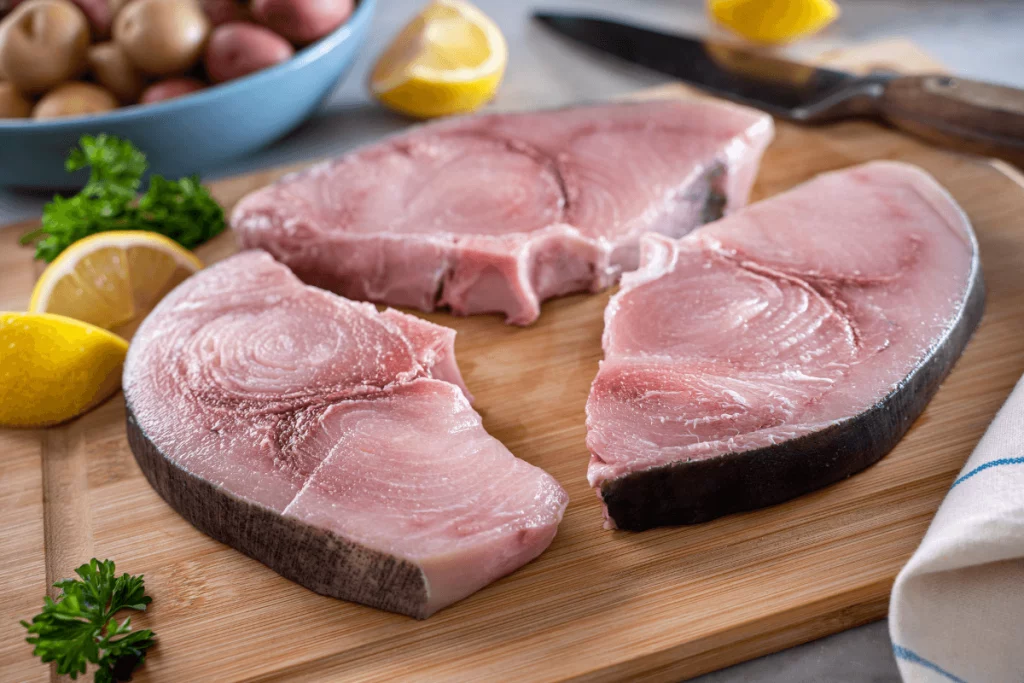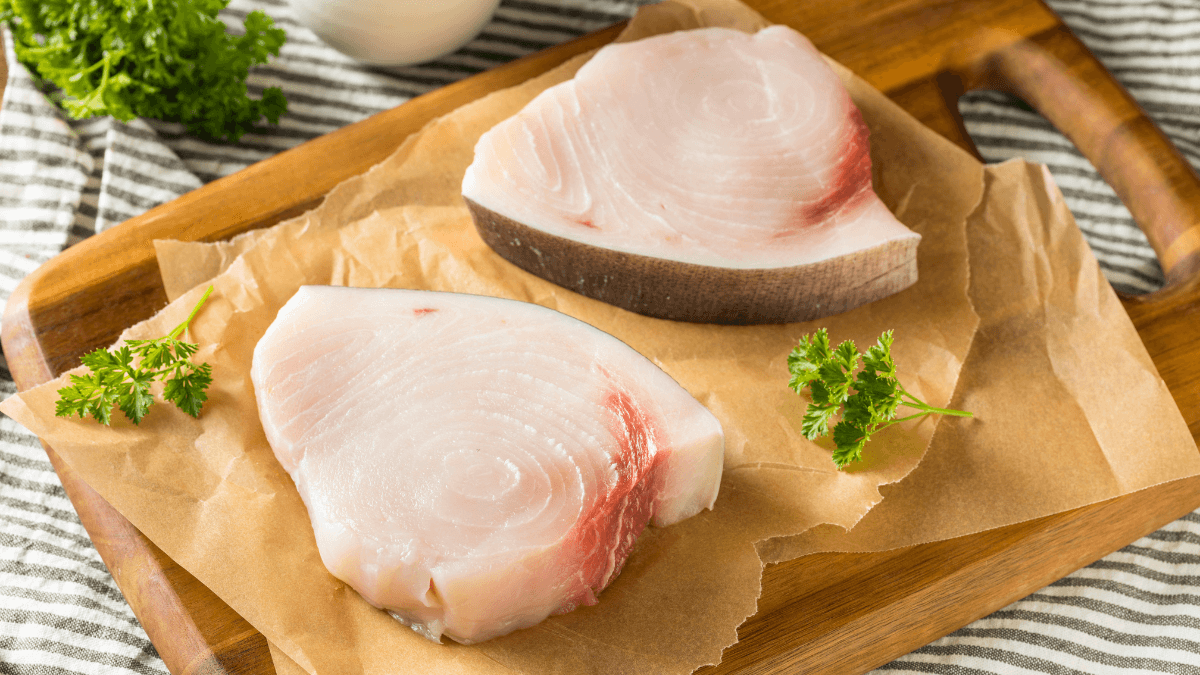Introduction to Swordfish
Swordfish, a true gem of the sea, offers a culinary experience like no other. Known for its distinctive taste and versatile nature in cooking, swordfish has been a long-time favorite among seafood lovers. In this article, we’ll explore everything about swordfish – from its unique characteristics to why it’s such a hit in kitchens around the world. Let’s dive into the world of swordfish and discover what makes this fish so special.
Understanding Swordfish
Swordfish are really something special. They’re not just any fish; they have this cool, sword-like bill that makes them stand out. These big guys are found in oceans all around the world – from the Atlantic to the Pacific and the Indian Ocean. They love to travel, swimming around in different seas.
Characteristics and Habitat
What’s really neat about swordfish is how big they can get. Imagine a fish as long as a small car and weighing as much as a grand piano! They like to swim deep in the ocean, hunting for smaller fish and squid. Their home is the open sea, and that’s where they grow up to be so big and tasty.
Culinary Popularity
Now, when it comes to eating, swordfish are a big hit. They’re not like regular fish; their meat is thick and kind of like steak. That’s why so many people love to cook them in different ways. You can grill them, broil them, or even fry them up. They’re popular all over the world because they taste so good and you can do so much with them in the kitchen.
In this article, we’re going to talk all about swordfish – what they taste like, how to cook them, and why they’re so loved by foodies. So, let’s get started and learn more about these amazing fish!
The Taste Profile of Swordfish
Describing Swordfish Flavor
When you take a bite of swordfish, the first thing you’ll notice is its unique flavor. It’s not too fishy, which is great for folks who aren’t big on seafood. Instead, swordfish has this mild, slightly sweet taste that’s really pleasant. It’s kind of like a welcome surprise in your mouth.
Mild and Slightly Sweet Taste
The sweetness of swordfish is subtle, but it’s definitely there. It’s a gentle flavor that makes you think of the ocean. This mildness is what makes swordfish so versatile in cooking. Whether you’re grilling, baking, or frying, swordfish takes on the flavors of the seasonings and sauces you use, making it a fantastic choice for a variety of dishes.
Comparison with Other Fish
Now, if you’re wondering how swordfish stacks up against other fish, here’s the scoop. Compared to tuna, swordfish is a bit milder and doesn’t have that strong fishy taste. It’s also meatier than flaky fish like cod or haddock. This meatiness makes swordfish steaks a great option for those who love a hearty meal but want to switch things up from the usual beef or pork steaks.
In the next part, we’ll explore what makes swordfish taste so good. Is it the way they’re cooked, or is there something special about them? Let’s find out!

What Makes Swordfish Taste Good?
Factors Influencing Swordfish Flavor
Ever wonder why swordfish tastes so good? It’s not just magic; there’s a whole bunch of reasons behind it. First off, where swordfish live and what they eat plays a big part. They munch on smaller fish and squid in the ocean, which gives them that unique, slightly sweet flavor.
Diet and Habitat Impact
Swordfish are like the travelers of the sea. They swim around in different oceans, and this traveling lifestyle affects their taste. The variety in their diet, depending on where they are, adds layers of flavor to their meat. It’s like each swordfish steak tells a story of the seas it’s traveled.
Preparation and Cooking Techniques
The way you cook swordfish can make a big difference in taste. Grilling or broiling brings out its natural flavors, giving it a slightly smoky taste that’s just irresistible. And because swordfish is so meaty, it holds up well to different cooking methods. You can marinate it, spice it up, or keep it simple with just some salt and pepper. No matter how you cook it, swordfish always turns out delicious.
In the next part, we’ll talk about the texture and aroma of swordfish. These aspects are just as important as the taste when it comes to enjoying this amazing fish.
Texture and Aroma
The Unique Texture of Swordfish
One of the most striking things about swordfish is its texture. Unlike many other fish that are flaky and light, swordfish is firm and meaty. It’s almost like biting into a tender steak. This hearty texture is a big part of what makes swordfish so satisfying to eat. It’s robust enough to stand up to grilling and searing, making it a favorite for those hearty, flavor-packed meals.
Dense and Meaty Feel
When you cook swordfish, it maintains its shape and doesn’t fall apart easily. This makes it a great choice for skewers or when you want a fish that can hold its own next to robust sides. The dense texture also means that each bite is full of flavor, absorbing marinades and spices beautifully, which enhances the overall dining experience.
Aroma and Freshness Indicators
Fresh swordfish has a clean, mildly oceanic aroma. It shouldn’t smell overly fishy or unpleasant. This fresh scent is a good indicator of quality and freshness. When cooked, swordfish releases a delightful aroma that’s appetizing but not overpowering, making it a great choice for a family dinner or a special occasion.
In the next part, we’ll delve into the best ways to cook swordfish. From grilling to broiling, we’ll explore how to bring out the best in this versatile fish.
Best Ways to Cook Swordfish

Swordfish is a culinary delight, offering versatility in cooking methods. Whether you’re a pro in the kitchen or just starting out, you’ll find that swordfish is easy and rewarding to cook. Here are some of the best ways to prepare this delicious fish:
Grilling and Broiling:
- Grilling swordfish brings out a wonderful smoky flavor, enhancing its natural taste. For the best results, keep the seasoning simple – a little olive oil, salt, and pepper usually does the trick.
- Broiling is another excellent method, especially if you love a slightly charred taste. It creates a delicious crust on the outside while keeping the inside juicy.
Other Cooking Methods:
- Pan-Searing: This method gives swordfish a gorgeous golden crust, sealing in all the juicy flavors. It’s quick and easy, perfect for a weeknight dinner.
- Baking: Ideal for a hassle-free cooking experience, especially when serving a group. Season the swordfish, place it in the oven, and let it bake to perfection.
Remember, the key to a perfect swordfish dish is to avoid overcooking. Aim for a moist and tender finish, not dry.
In the next part, we’ll delve into the health and nutritional aspects of swordfish. It’s not just tasty; it’s packed with benefits too!
For a delicious variation, try this Lemon Garlic Swordfish recipe, which perfectly complements the natural flavors of the fish.
Health and Nutrition
Swordfish isn’t just a treat for your taste buds; it’s also packed with nutritional benefits. Let’s dive into what makes this fish a healthy choice:
Rich in Proteins and Nutrients
Swordfish is not just yummy; it’s also really good for you. It’s packed with lean protein, which is great for keeping your muscles strong. Plus, it’s full of important stuff like selenium, niacin, and vitamin B12. These nutrients help keep your body healthy, supporting everything from your immune system to your energy levels.
Considerations of Mercury Content
One thing to keep in mind about swordfish is that it can have a bit more mercury than other fish. This is especially important for pregnant women, nursing moms, and little kids to know. But don’t worry, as long as you don’t eat it every day, it’s usually fine for most people. Mixing it up with other fish that have less mercury, like salmon or tilapia, is a smart move.
Check this article to discover more about high mercury fish
Next up, we’ll talk about how to pick the best swordfish and how to keep it fresh. Knowing these tips will help you get the most out of this tasty fish.
Selecting and Storing Swordfish
Picking the right swordfish and keeping it fresh can make a big difference in how it tastes. Here are some tips to help you out:
Choosing the Best Swordfish
When you’re at the store or fish market, look for swordfish that looks fresh and smells clean. Here’s what to keep an eye out for:
- Freshness Indicators: Fresh swordfish steaks should have a nice, ivory color. They shouldn’t look dried out or have any brown spots. A fresh fishy smell is okay, but it shouldn’t be too strong or unpleasant.
- Texture: Give the fish a gentle poke. It should feel firm, not mushy. That’s a sign it’s fresh and good quality.
Storage Tips
Got your swordfish? Great! Now, let’s make sure it stays good until you’re ready to cook it:
- In the Fridge: If you’re cooking the swordfish within a day or two, just pop it in the fridge. Keep it in its original packaging or wrap it up well.
- In the Freezer: If you won’t be cooking it right away, you can freeze it. Wrap it tightly in plastic wrap or aluminum foil, and it’ll be good for a couple of months.
Remember, whether you’re storing it in the fridge or freezer, keep it away from other foods to avoid any cross-contamination.
FAQs About Swordfish
- Q: Can you eat swordfish raw?
- A: Yes, you can eat swordfish raw, like in sushi, but it’s important to make sure it’s super fresh and properly handled to avoid any health risks.
- Q: How often can I safely eat swordfish?
- A: Because of its mercury content, it’s best to eat swordfish in moderation. For most adults, having it once a week is a good balance.
- Q: What are the best seasonings for swordfish?
- A: Swordfish is pretty versatile. Simple seasonings like olive oil, lemon, salt, and pepper work great. You can also try herbs like basil or cilantro for extra flavor.
- Q: How do I know if my swordfish is cooked properly?
- A: Swordfish is done when it’s opaque all the way through and flakes easily with a fork. Be careful not to overcook it, or it’ll get dry.
- Q: What side dishes go well with swordfish?
- A: Swordfish pairs well with a lot of sides. Grilled veggies, a fresh salad, or even some roasted potatoes are all great choices.
- Q: Is swordfish good for grilling?
- A: Absolutely! Its firm texture makes it perfect for grilling. Just brush it with some oil and your favorite seasonings, and you’re good to go.
Conclusion
So, there you have it – a deep dive into the world of swordfish. From its unique taste and texture to the best ways to cook and enjoy it, swordfish truly stands out in the seafood world. It’s not just a treat for your palate but also brings a bunch of health benefits to your table, as long as you consume it in moderation considering its mercury content.
Remember, the key to a great swordfish experience lies in choosing fresh, high-quality fish and cooking it just right – not too much, not too little. Whether you’re grilling it for a summer BBQ or pan-searing it for a cozy dinner, swordfish is sure to impress.
We hope this guide has inspired you to try swordfish in your next culinary adventure and enjoy all the flavors and benefits it has to offer. Happy cooking and bon appétit!

